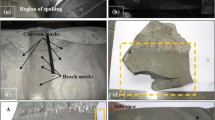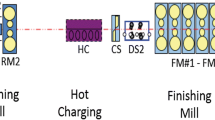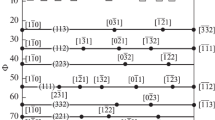Abstract
A metallurgical investigation of failed samples of hot-strip mill work-rolls used in an integrated steel plant was made to determine the influence of microstructural characteristics on failure susceptibility and roll life. The samples investigated pertained to prematurely failed indefinite chill double-poured (ICDP) iron work-rolls, which exhibited varying roll lives under similar mill operating environments. Although microstructures of all the investigated rolls showed similar graphite morphologies irrespective of their mill performance, discernible differences in carbide characteristics could be observed between high and low life rolls. Microstructural observation of nital-etched roll specimens revealed that lower life rolls were characterized by carbide microcracking. The propensity for cracking was particularly high in carbides exhibiting microhardness greater than 1020 VPN. Electron-probe microanalysis (EPMA) indicated that carbides in the spalled rolls were mostly of M3C type, where M was Fe and Cr. Quantitative image analysis of phases in the investigated rolls revealed that while graphite volume fraction in the range of 4.0 to 6.4% did not significantly affect roll life, carbide content higher than 28.5 vol% was found detrimental. In fact, a carbide content in the range of 24.0 to 28.50 vol% was found to be desirable for higher roll life. The study thus revealed that although carbides are indispensable for high hardness, resistance to wear, and thermal cracking, an excessive volume fraction (>30 vol%) of high hardness (microhardness > 1020 VPN) carbides accentuated microcracking, which ultimately induced premature spalling of hot-strip mill work-rolls.
Similar content being viewed by others
References
P.J. Horvath: “Relationship between Roll. Surface Breakdown and Scale Formation,” 22nd Mechanical Working and Steel Processing Conf. Proc., Iron and Steel Society, Warrendale, PA, 1980, vol. 18, pp. 238–49.
B. Feistritzer, K.H. Schroder, M. Windhager, and K.H. Ziehenberger: “Indefinite Chill: Upgrading on Old HSM Work Roll Grade,” 41st Mechanical Working and Steel Processing Conf. Proc., Iron and Steel Society, Warrendale, PA, 1999, vol. 37, pp. 103–08.
C. Lecomte-Mertens: “Study of the Process Leading to Spalling of Cast Mill Work Rolls,” 33rd Mechanical Working and Steel Processing Conf. Proc., Iron and Steel Society, Warrendale, PA, 1992, vol. 29, pp. 119–28.
R. Elliott: Cast Iron Technology, Butterworth and Co. Ltd., London, 1988, p. 25.
R.R. Judd: “Surface Deterioration of Grain Iron Work Rolls in the First Stands of a Hot Strip Mill Finishing Train,” Iron and Steel Engineer, 1979, 56(1), pp. 51–60.
H.R. Hertz: J. Reine Angew. Math., 92, 1981, pp. 156–71.
Author information
Authors and Affiliations
Rights and permissions
About this article
Cite this article
Ray, A., Prasad, M.S., Barhai, P.K. et al. Metallurgical investigation of prematurely failed hot-strip mill work-rolls: Some microstructural observations. J Fail. Anal. and Preven. 4, 58–66 (2004). https://doi.org/10.1007/s11668-996-0016-8
Received:
Revised:
Issue Date:
DOI: https://doi.org/10.1007/s11668-996-0016-8




